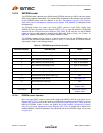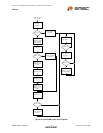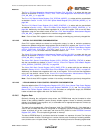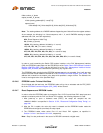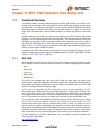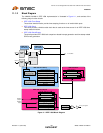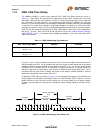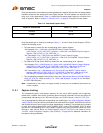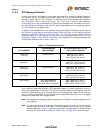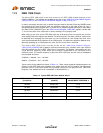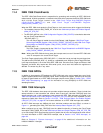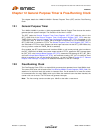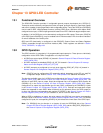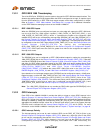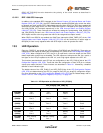
Two Port 10/100 Managed Ethernet Switch with 16-Bit Non-PCI CPU Interface
Datasheet
Revision 1.4 (08-19-08) 158 SMSC LAN9311/LAN9311i
DATASHEET
Clock synchronization and hardware processing between the network data and the time stamp capture
hardware causes the time stamp point to be slightly delayed. The host software can account for this
delay, as it is fairly deterministic. Table 11.2 details the time stamp capture delay as a function of the
mode of operation. Refer to Chapter 7, "Ethernet PHYs," on page 82 for details on these modes.
Once the packet type is matched, according to Table 11.1, and the Frame Check Sequence (FCS) is
verified, the following occurs:
The time stamp is loaded into the corresponding ports’ capture registers:
–On Reception: Port x 1588 Clock High-DWORD Receive Capture Register
(1588_CLOCK_HI_RX_CAPTURE_x) and Port x 1588 Clock Low-DWORD Receive Capture
Register (1588_CLOCK_LO_RX_CAPTURE_x)
–On Transmission: Port x 1588 Clock High-DWORD Transmit Capture Register
(1588_CLOCK_HI_TX_CAPTURE_x) and Port x 1588 Clock Low-DWORD Transmit Capture
Register (1588_CLOCK_LO_TX_CAPTURE_x)
The Sequence ID and Source UUID are loaded into the corresponding ports’ registers:
–On Reception: Port x 1588 Sequence ID, Source UUID High-WORD Receive Capture Register
(1588_SEQ_ID_SRC_UUID_HI_RX_CAPTURE_x) and Port x 1588 Source UUID Low-
DWORD Receive Capture Register (1588_SRC_UUID_LO_RX_CAPTURE_x)
–On Transmission: Port x 1588 Sequence ID, Source UUID High-WORD Transmit Capture
Register (1588_SEQ_ID_SRC_UUID_HI_TX_CAPTURE_x) and Port x 1588 Source UUID
Low-DWORD Transmit Capture Register (1588_SRC_UUID_LO_TX_CAPTURE_x)
The corresponding maskable interrupt flag is set in the 1588 Interrupt Status and Enable Register
(1588_INT_STS_EN). (Refer to Section 11.6, "IEEE 1588 Interrupts," on page 161 for information
on IEEE 1588 interrupts.)
Note: Packets that do not contain an integral number of octets are not considered valid and do not
cause a capture.
11.2.1 Capture Locking
The corresponding ports’ clock capture, sequence ID, and source UUID registers can be optionally
locked when a capture event occurs, preventing them from being overwritten until the host clears the
corresponding interrupt flag in the 1588 Interrupt Status and Enable Register (1588_INT_STS_EN).
This is accomplished by setting the corresponding lock enable bit(s) in the 1588 Configuration Register
(1588_CONFIG). Each port has two lock enable control bits within this register, which allow the receive
and transmit portions of each port to be locked independently. In addition, a lock enable bit is provided
for each time stamp enabled GPIO (LOCK_ENABLE_GPIO_8 and LOCK_ENABLE_GPIO_9) which
prevents the corresponding GPIO clock capture registers from being overwritten when the GPIO
interrupt in 1588 Interrupt Status and Enable Register (1588_INT_STS_EN) is set. Refer to Section
14.2.5.22, "1588 Configuration Register (1588_CONFIG)," on page 223 for additional information on
the capture locking related bits.
Table 11.2 Time Stamp Capture Delay
MODE OF OPERATION DELAY (+/- 10 nS)
100 Mbps 30 nS
10 Mbps 120 nS



